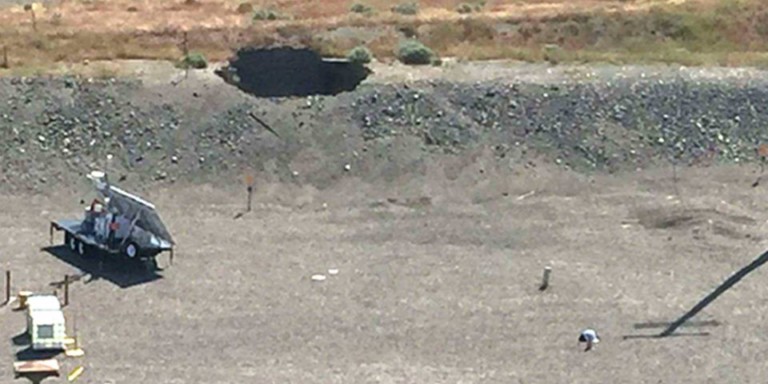Tunnel Collapse Leads to Emergency Evacuation at Hanford Nuclear Site
Posted May 10, 2017 by Ryan Fitzgerald | A Nuclear World

A tunnel collapse on Tuesday, May 9th at the Hanford Nuclear Site in Washington has resulted in an emergency evacuation of the area. Immediately following the incident, workers were told to take cover indoors, cut all ventilation from the outside, and refrain from eating or drinking until the situation was properly assessed. Rail cars use the tunnel to transport containing hot radioactive material, and the breach has the potential to release large amounts of radioactive pollution into the surrounding area.
Brief History of the Hanford Nuclear Site
The Hanford Nuclear Site is the largest source of radioactive waste and pollution in all of North America. It played a major contribution in the Manhattan Project during World War II, and maintained operations until the ending period of the Cold War in 1989. Its primary function was the production of plutonium to be used in the creation of nuclear weapons. The site is currently home to large underground tanks that hold millions of gallons of liquid radioactive waste. Hundreds of gallons of radioactive waste have been reported leaking from the tanks, resulting in contamination of the soil and the nearby Columbia River. Billions of dollars continue to be spent every year by the federal government as they try to contain and dispose of the radioactive waste located on the site, which will not be completely decommissioned for decades.

The Situation Following the Tunnel Collapse
A few hours after the emergency sheltering and evacuation had begun, the Department of Energy released their first press statement.
Secretary Perry has been briefed on the incident at DOE’s Hanford site. Everyone has been accounted for and there is no initial indication of any workers exposure or an airborne radiological release. The Department will continue to monitor this closely and will provide information and updates as they become available.
A statement made later that evening noted that the workforce aside from the critical personnel working on containing the situation had left the site. It was also stated that the situation had gone from the emergency phase to a recovery phase. At this time no one else is being allowed on the site, and a no fly zone has been issued over the area.
May 13th Hanford Tunnel Collapse Update
In recent news, the collapsed tunnel discovered at the Hanford Nuclear Site on May 9th may have gone unnoticed for several days. Mark Heeter, spokesman for the energy department made a statement that they were unsure of when the tunnel had collapsed, but it could have been up to four days prior to its discovery. Alarms would have immediately alerted staff if any radiation had escaped from the collapsed tunnel into the environment, but the infrequency of patrol checks at these dangerous tunnels is frightening. The tunnel has since been repaired, and it is reported that no radiation escaped and no workers were harmed during the process. Despite this, skepticism over the safety of the Hanford Nuclear Site has increased. Secretary of Energy, Rick Perry has stated that the next step at Hanford is to reduce the risk of future accidents and implement long-term measures to increase safety at the site.
May 19th Underground Tank Leak Discovered
Only nine days after the collapsed tunnel at the Hanford Nuclear Site forced an evacuation of the area, a second incident has occurred that has potentially harmed crew members. On the night of May 18th, a seven-man crew was doing a routine evaluation of one of the underground tanks holding hot radioactive waste. The robot used to complete the evaluation came back with radiation levels three times higher than expected. The crew immediately left the area, but traces of radiation were found on three articles of clothing from one of the crew members which were promptly disposed of. The unexpected radiation levels found in the area around tank AZ 101 are indicative of a leak that threatens to pollute the nearby Columbia River. AZ 101 was installed in 1976, and was given a life expectancy of 20 years, meaning it has been in use for twice its expected life time. The lack of security and safety regulations at Hanford are cause for serious concern. Hopefully recent incidents prompt the federal government to get involved in a much needed overhaul of the area, before any more lives are endangered.
Stay tuned for future updates on the situation at the Hanford Nuclear Site.
Comments ( 0 )